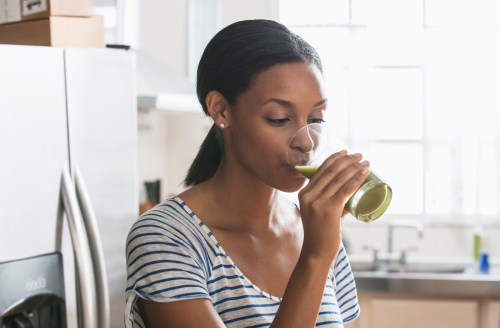4 Meal-Prep Tips to Ensure Your Plant-Based Breakfasts Are Easy *and* Packed With Protein
Struggling with easy plant-based morning meals? Check out these smart vegan breakfast meal prep hacks to make your a.m. meal healthier (and faster to cook).

Despite its reputation as being the “most important” meal of the day, breakfast is often looked by many of us busy healthy eaters. Even if you’re WFH, it’s easy for breakfast to become an afterthought or just a vehicle for your oat milk latte. Who has time to make a scramble or hot oatmeal every morning when you have to hop on a Zoom call or haul yourself in the car for a commute?
The breakfast struggle can be even trickier if you’re plant-based, as a few more traditional breakfast go-tos—eggs, yogurt, turkey bacon or sausage patties—are off the table.
That’s why meal-prepping your breakfast—yes really—can reap massive rewards. You spend a bit of time up-front prepping in order to come away with something that requires very minimal legwork in the morning. (The dream!) Plus if you’re plant-based, you can ensure that you’re meeting all of your nutritional needs ahead of time so that your a.m. meal is truly satisfying and filling.
With that in mind, we asked a few dietitians to share some of their plant-based and vegan breakfast meal prep tips to make things easier in the morning. These tips will let you have some flexibility with your breakfast, while still ensuring you hit all of your nutritional buckets. What’s not to love?
1. Prep Protein “Boosters” To Add to Everything
Without animal products (and some intentional planning), it’s easy to accidentally skimp on protein—but that’s a big mistake at breakfast. “The worst thing is having breakfast is and getting hungry an hour after,” says Maggie Michalczyk, RD. Protein is digested more slowly and contributes to satiety and longer-lasting energy, making a crucial macronutrient first thing in the day.
Thankfully, there are lots of breakfast-friendly plant proteins. Michalczyk likes to make her own nut and seed mix to sprinkle on oatmeal, chia pudding, and plant-based yogurt to get some extra protein. Mix and match hemp seeds, chia seeds, ground flax seeds, pumpkin seeds, and walnut or almonds and put in pre-portioned containers or bags so that you can just grab and go.
Kelly Jones, RD, also recommends hemp seeds for a quick protein boost. “Per three-tablespoon serving, [hemp seeds] provide 10 grams of protein and 20 percent of the daily recommendations for iron, two nutrients people are often concerned with when they transition to a plant-based eating pattern,” she says. You can use them like a protein booster for nearly anything, from pancakes to smoothies.
2. Pre-Portion Your Smoothie Ingredients
Most smoothies are plant-based, so it’s worth doing some legwork in advance to make a.m. blending go a lot more smoothly.
“Place greens, fruit, and nuts and seeds into a reusable freezer bag so that you have them ready to go and all you have to do is add non-dairy milk of your choice and a plant-based protein powder when you’re ready to make a smoothie for breakfast,” says Jones. “This is also a great way to prevent food waste when let’s say your banana is about to go bad or greens—simply put them in a bag and freeze for a future breakfast.”
3. Make Sure Your Alt-Milk Is a Good Protein Source
You might love the taste of almond milk, but it’s not super high in protein compared to other alt-milks on the market. “Ensuring your non-dairy milk alternative actually contains protein is an easy way to pack in [some] extra grams in the morning,” says Jones.
“While soy milk contains eight grams [of protein] and is widely available, plant-based diets are already usually high in soy, so I like to advocate for variety in your protein source,” she says.
Oat milk is a great option, and Jones likes Califia Farms Protein Oat Milk, which has eight grams of plant protein, including all nine essential amino acids from peas, oats, and sunflower seed butter (making it allergen free, too). “It also offers healthy fats and more calcium than a cup of dairy milk, and the texture is more smooth that other pea milks I have tried,” she says. Use that protein-packed milk when you make oatmeal, smoothies, or cereal, and add in hemp seeds or chia seeds for even more nutrition.
4. Optimize Your Toast
There are few things more satisfying that toast, and you can enjoy some on a plant-based diet without missing out on nutrition. “It’s so easy to add a couple of pieces of bread to the toaster and slather on some nut butter before topping with fruit, but if you’ve removed eggs from your diet and don’t have time for a tofu scramble, protein content may be low,” Jones says. So, bump up the protein!
“Aim for bread that has at least five grams of protein per slice. I’ve been telling all of my clients to stock Trader Joe’s Sprouted Wheat Sourdough ($4). It has seven grams of protein per slice, and sprouted grains are known for being better on the digestive tract,” she says. Just two slices, each topped with half a tablespoon of peanut butter and your favorite fruit, get your morning started with at least 17 grams of protein and at least six grams of filling fiber. Not too shabby!
Sign Up for Our Daily Newsletter
Get all the latest in wellness, trends, food, fitness, beauty, and more delivered right to your inbox.
Got it, you've been added to our email list.










